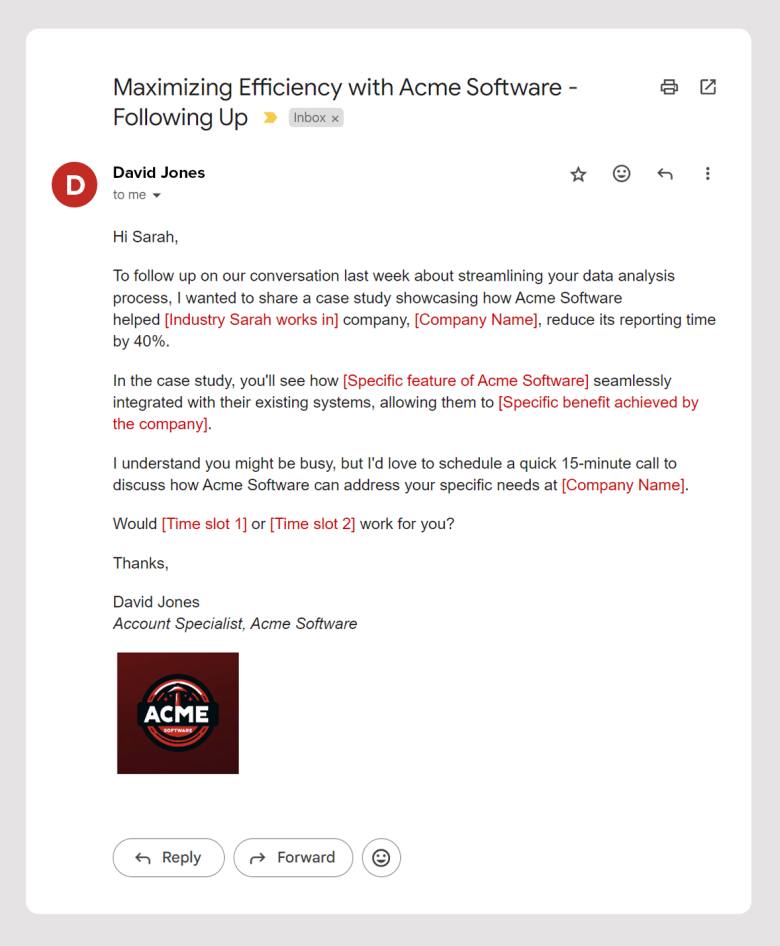Sales Email Follow-Up Generator (with Templates and Best Practices)
At Media Shower, we know sales. This guide provides AI prompts, examples, and battle-tested best practices for busy marketing and sales managers like you. And don’t waste time crafting emails from scratch: close more deals faster with our AI-powered sales email generator.
How to Use our Sales Email Generator
Custom-built for sales and marketing teams, our AI assistant will create great sales emails, quickly and easily. Remember: the more information you give it, the better sales email you’ll get.
AI Prompts for Refining Sales Emails
Once you’ve drafted your sales email template above, here are ready-to-use prompts you can use to polish and perfect them.
- Refine Content:
Optimize this email for clarity and brevity without losing the main points. - Alter Tone:
Rewrite this as more formal/playful/informal. - Strengthen Call-to-Action:
Make the call-to-action more compelling and clear. - Personalize Message:
Customize this message to resonate more with a [specific segment, e.g., tech industry professionals]. - Address Concerns:
Include responses to potential objections or questions the recipient might have. - Highlight Value:
Emphasize the unique value proposition of our offer more prominently. - Be Consistent:
Ensure this follow-up aligns with our brand voice and the previous emails sent.
Examples of Sales Email Follow-Ups
Here are some examples of sales email follow-ups:
Apple Sales Email Followup
 Image Source: Hubspot
Image Source: Hubspot
This Apple sales email follow-up maintains a positive and helpful tone throughout. The email creates a friendly and supportive customer service experience by addressing Steven by name.
The brief email gets straight to the point by asking about the requested information. Additionally, it avoids any forceful language or sales pressure by simply checking in and offering help, creating a more relaxed interaction that might encourage Steven to respond.
These combined elements create a positive and helpful interaction, leaving a good impression of Apple’s customer service approach.
Twilio Sales Email Followup
 Image Source: Hubspot
Image Source: Hubspot
Twilio’s sales follow-up email effectively grabs Howard Schultz’s attention by demonstrating personalization and targeting him directly. Emerald goes beyond generic features and tailors the message to Starbucks’ specific needs, showcasing creative solutions that could enhance their customer experience.
Her enthusiastic tone and openness to further conversation leaves a positive impression and encourages Howard to schedule a meeting to explore how Twilio can benefit Starbucks.
Groove Sales Email Followup
 Image Source: Close
Image Source: Close
This follow-up email effectively re-engages Alex with Groove, a simple help desk software platform, by offering renewed value, minimizing barriers to trying again, and maintaining a positive and helpful tone.
The sender uses friendly and positive language throughout, creating a welcoming atmosphere and leaving a good impression. The email concludes with a clear call to action and simple instructions on activating another 14-day trial.
Take a free trial of the Media Shower platform, where our team can turn your sales emails into lead magnets.
Example of Sales Email Follow-Ups for Busy Marketing Managers

Best Practices for Following Up on Sales Emails
- Segment Your Audience: Categorize recipients based on behavior, interaction, or profile for targeted follow-ups. For instance, segment leads who haven’t downloaded a white paper but opened an email about a free trial into a group that receives a more prominent call to action for the trial. Segmentation allows for more relevant messaging, increasing engagement and conversion rates. This Campaign Monitor article dives into the concept of segmentation in email marketing, explaining its benefits and various segmentation strategies.
- Test and Optimize: A/B tests different follow-up versions and optimizes for best results. Don’t be afraid to experiment with different subject lines, email structures, and CTAs. Track your open, click-through, and reply rates to see which versions resonate best with your audience. To streamline this process, utilize A/B testing tools many email marketing platforms offer. This resource provides a helpful guide on A/B testing for email marketing campaigns, including best practices and step-by-step instructions.
- Keep Copy Concise: Trim unnecessary fluff to ensure a clear and direct message. People are busy, so get to the point quickly. Focus on your product or service’s value proposition and explain how it directly benefits the recipient.
- Enhance Personalization: Implement AI-driven data to tailor messages to individual recipients or segments. Go beyond just a name by referencing past interactions, specific industry challenges, or website behavior. Personalization software can analyze customer data to craft highly relevant and engaging emails. This Forbes article explores the power of personalization in email marketing, showcasing its impact on customer engagement and conversion rates.
- Monitor Engagement: Measure recipient engagement and adapt follow-ups accordingly. Track open rates, clicks, and replies to see which emails resonate and which fall flat. Use this data to inform future follow-up strategies. For example, if someone consistently opens emails but doesn’t click on links, consider offering a phone call instead.
- Be Timely: Schedule follow-ups at optimal times based on recipient time zones or past engagement patterns. Sending emails during peak business hours in the recipient’s time zone might not be the most effective approach. Consider using marketing automation tools to schedule emails based on past open and click-through rates. This SendGrid article offers data-driven insights on the best times to send marketing emails, including considerations for different time zones and industries.
- Ensure Consistency: Align emails with brand voice, tone, and overall messaging strategy. Your follow-up emails should maintain a consistent voice and tone that reflects your brand identity. This creates a professional and cohesive customer experience.

7 Frequently Asked Questions About Sales Email Follow-ups
What is the optimal timing for a sales email follow-up?
Typically, waiting 3-7 days after the initial email gives recipients time to respond. Adjust based on feedback and engagement data.
How many follow-ups should I send before stopping?
While there's no fixed number, 3-4 follow-ups are standard. However, avoid being overly persistent to prevent coming off as spammy.
Is personalization crucial in follow-up emails?
Yes, personalized emails often yield higher engagement rates. Use recipient data to tailor your message and increase its relevance. This information can go into subject lines or the body of the message as variables.
How do I handle recipients who've asked not to be contacted again?
Always respect opt-out requests. Implement systems to ensure those opting out don't receive further communications.
What metrics should I track for sales email follow-ups?
Focus on open, response, and conversion rates to track how users engage with your emails. These provide insights into the effectiveness of your messaging.
Should my follow-up have the same call-to-action (CTA) as the original email?
It can, but consider varying the CTA to offer a different perspective or value. Sometimes, a new angle can capture attention.
How do I ensure my follow-up emails don't land in spam?
Maintain a clean email list, avoid spammy language, and ensure proper email authentication. If you’re working through a reputable mass email provider, they will typically have controls to help you avoid landing in the spam folder. Regularly monitor deliverability metrics.
7 Protips for Following Up on Sales Emails
- Subject Line Impact: Make it intriguing. Use AI tools or brainstorming to craft compelling subject lines that prompt recipients to open the email.
- Follow-up Cadence: Don’t overwhelm. Space out your follow-up emails strategically based on previous engagement and feedback.
- Content Variety: Mix your approach. Use different content types, like testimonials, case studies, or new offers, to re-engage recipients in follow-ups.
- Personal Touch: Go beyond names. To increase relevance, personalize content based on industry, company size, or past interactions.
- CTA Optimization: Be clear and concise. Optimize your call-to-action to make the next steps evident and inviting.
- Performance Analysis: Constantly refine. Use analytics to assess which follow-up strategies work best and adjust accordingly.
- Social Proof Integration: Show, don’t tell. Incorporate testimonials, endorsements, or case studies in your follow-ups to bolster credibility.
Take a free trial of the Media Shower platform, where our team can turn your sales emails into lead magnets.


